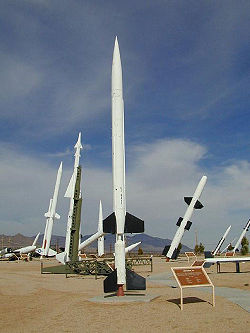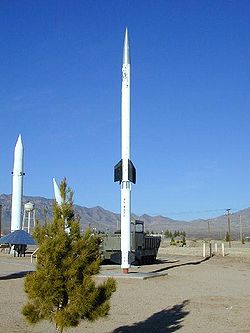
Aerobee rocket
Encyclopedia

Sounding rocket
A sounding rocket, sometimes called a research rocket, is an instrument-carrying rocket designed to take measurements and perform scientific experiments during its sub-orbital flight. The origin of the term comes from nautical vocabulary, where to sound is to throw a weighted line from a ship into...
used for high atmospheric and cosmic radiation research in the United States
United States
The United States of America is a federal constitutional republic comprising fifty states and a federal district...
in the 1950s.
It was built by Aerojet General. The company began work in 1946 and test fired the first complete Aerobee from the White Sands Proving Grounds in New Mexico
New Mexico
New Mexico is a state located in the southwest and western regions of the United States. New Mexico is also usually considered one of the Mountain States. With a population density of 16 per square mile, New Mexico is the sixth-most sparsely inhabited U.S...
on 1947-11-24. It reached an altitude of 34.7 miles (55.8 km).
The rocket was two stage with a solid-fuel boost and a nitric acid
Nitric acid
Nitric acid , also known as aqua fortis and spirit of nitre, is a highly corrosive and toxic strong acid.Colorless when pure, older samples tend to acquire a yellow cast due to the accumulation of oxides of nitrogen. If the solution contains more than 86% nitric acid, it is referred to as fuming...
/aniline
Aniline
Aniline, phenylamine or aminobenzene is an organic compound with the formula C6H5NH2. Consisting of a phenyl group attached to an amino group, aniline is the prototypical aromatic amine. Being a precursor to many industrial chemicals, its main use is in the manufacture of precursors to polyurethane...
sustainer. The rockets could reach around 230 km (a later variant exceeded 400 km). Instrumentation usually provided constant telemetry and was recovered by parachute. For accurate pointing special gimbal mounts were developed.
Aerobees were launched from 53 m tall launch towers to provide the necessary stability until the rockets gained enough speed for their fins to be effective in controlling attitude. Launch towers were built at White Sands Missile Range
White Sands Missile Range
White Sands Missile Range is a rocket range of almost in parts of five counties in southern New Mexico. The largest military installation in the United States, WSMR includes the and the WSMR Otera Mesa bombing range...
, Fort Churchill
Fort Churchill (rocket launch site)
Fort Churchill is a rocket launching complex located in Churchill, Manitoba. The site has been used on and off since the mid-1950s for sub-orbital launches of various sounding rockets during several major studies...
, Wallops Island
Wallops Island
Wallops Island is a island off the east coast of Virginia, part of the barrier islands that stretch along the eastern seaboard of the United States of America.It is located in Accomack County, Virginia...
, and aboard the research vessel USS Norton Sound. The Aerobee could take a 68 kg payload to an altitude of 130 km.
The first instrument-carrying Aerobee was the A-5, launched on March 5, 1948 from White Sands, carrying instruments for cosmic radiation research, reaching an altitude of 117.5 km. When the last Aerobee flew at White Sands in 1958, around 165 (including variants) had been successfully fired at that location. Variants of the Aerobee were launched in 1968 and 1969 for research relating to the Apollo program. The Aerojet engineers also developed the Aerobee-Hi (first launched in 1955).
A total of 1,037 Aerobees (including variants) were launched from all locations, the last on January 17, 1985.
Aerobee
- Payload: 68 kg
- Maximum flight altitude: 130 km
- Liftoff Thrust: 18 kN
- Total Mass: 727 kg
- Core Diameter: 0.38 m
- Total Length: 7.80 m
Aerobee 75
- Maximum flight altitude: 80 km
- Liftoff Thrust: 7.00 kN
- Total Mass: 400 kg
- Total Length: 6.00 m

Aerobee 150
- Payload: 68 kg
- Maximum flight altitude: 270 km
- Liftoff Thrust: 18 kN
- Total Mass: 930 kg
- Core Diameter: 0.38 m
- Total Length: 9.30 m
Aerobee 170
- Maximum flight altitude: 200 km
- Liftoff Thrust: 225 kN
- Total Mass: 1,270 kg
- Core Diameter: 0.42 m
- Total Length: 12.60 m
Aerobee 170A
- Maximum flight altitude: 200 km
- Liftoff Thrust: 217 kN
- Total Mass: 1,270 kg
- Core Diameter: 0.42 m
- Total Length: 12.40 m
Aerobee 170B
- Maximum flight altitude: 200 km
- Liftoff Thrust: 225 kN
- Total Mass: 1,270 kg
- Core Diameter: 0.42 m
- Total Length: 12.40 m
Aerobee 200
- Maximum flight altitude: 250 km
- Liftoff Thrust: 225 kN
- Total Mass: 1,600 kg
- Core Diameter: 0.42 m
- Total Length: 12.60 m
Aerobee 300
- Payload: 45 kg
- Maximum flight altitude: 300 km
- Liftoff Thrust: 18 kN
- Total Mass: 983 kg
- Core Diameter: 0.38 m
- Total Length: 9.90 m
Aerobee 350
- Payload: 227 kg
- Maximum flight altitude: 450 km
- Liftoff Thrust: 217 kN
- Total Mass: 3,839 kg
- Core Diameter: 0.56 m
- Total Length: 15.90 m
- Span: 2.30 m

